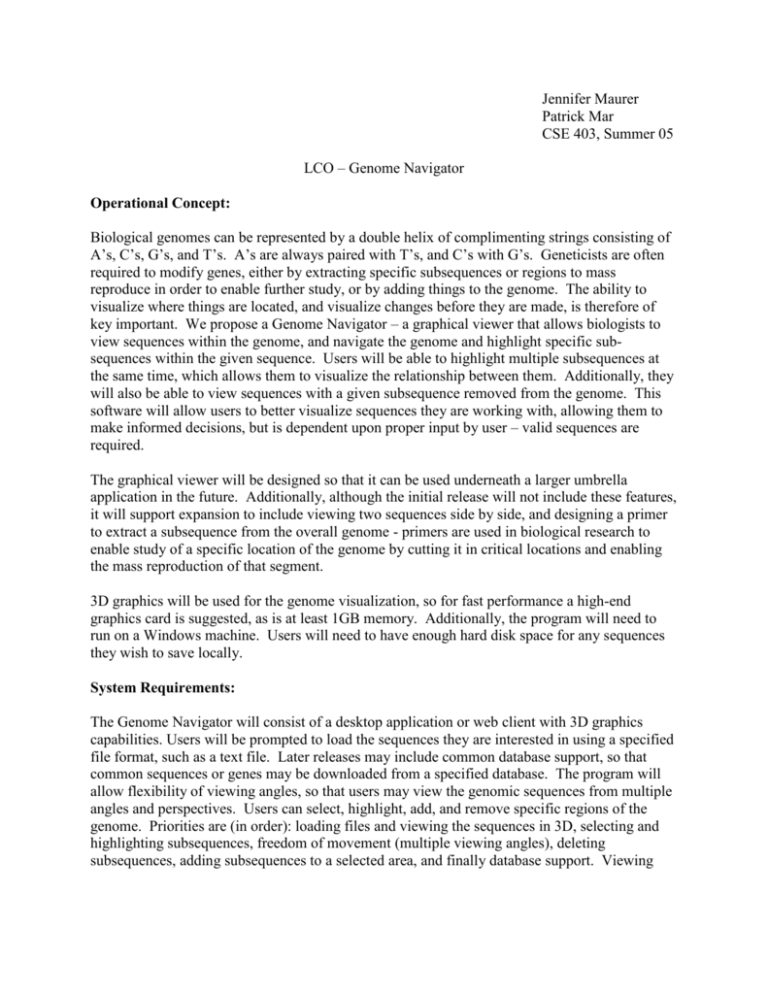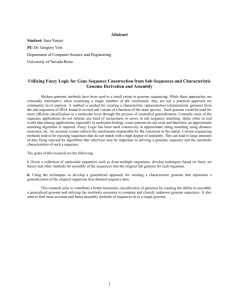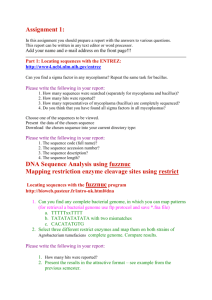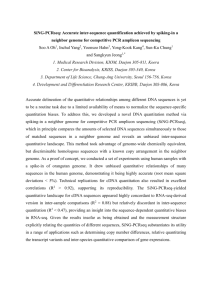doc
advertisement

Jennifer Maurer Patrick Mar CSE 403, Summer 05 LCO – Genome Navigator Operational Concept: Biological genomes can be represented by a double helix of complimenting strings consisting of A’s, C’s, G’s, and T’s. A’s are always paired with T’s, and C’s with G’s. Geneticists are often required to modify genes, either by extracting specific subsequences or regions to mass reproduce in order to enable further study, or by adding things to the genome. The ability to visualize where things are located, and visualize changes before they are made, is therefore of key important. We propose a Genome Navigator – a graphical viewer that allows biologists to view sequences within the genome, and navigate the genome and highlight specific subsequences within the given sequence. Users will be able to highlight multiple subsequences at the same time, which allows them to visualize the relationship between them. Additionally, they will also be able to view sequences with a given subsequence removed from the genome. This software will allow users to better visualize sequences they are working with, allowing them to make informed decisions, but is dependent upon proper input by user – valid sequences are required. The graphical viewer will be designed so that it can be used underneath a larger umbrella application in the future. Additionally, although the initial release will not include these features, it will support expansion to include viewing two sequences side by side, and designing a primer to extract a subsequence from the overall genome - primers are used in biological research to enable study of a specific location of the genome by cutting it in critical locations and enabling the mass reproduction of that segment. 3D graphics will be used for the genome visualization, so for fast performance a high-end graphics card is suggested, as is at least 1GB memory. Additionally, the program will need to run on a Windows machine. Users will need to have enough hard disk space for any sequences they wish to save locally. System Requirements: The Genome Navigator will consist of a desktop application or web client with 3D graphics capabilities. Users will be prompted to load the sequences they are interested in using a specified file format, such as a text file. Later releases may include common database support, so that common sequences or genes may be downloaded from a specified database. The program will allow flexibility of viewing angles, so that users may view the genomic sequences from multiple angles and perspectives. Users can select, highlight, add, and remove specific regions of the genome. Priorities are (in order): loading files and viewing the sequences in 3D, selecting and highlighting subsequences, freedom of movement (multiple viewing angles), deleting subsequences, adding subsequences to a selected area, and finally database support. Viewing more than one sequence at a time and the ability to design a primer may also be added as future additions. Software and System Architecture: Option 1: Completely contained desktop application with locally loaded sequences. This would not require outside database connections or any network support. The user would load all sequence files. This limits the usability of the program to some degree, as users would need to have access to genome sequences, and would be required to re-load any sequences that were updated. However, although it means slightly more work for the user, researchers can be expected to have access to the genomic sequence they are modifying, so it is both reasonable and feasible. OpenGL would be a possible option for the graphical display of the program. Option 2: Desktop application with both locally loaded sequences and database support. This would require that someone on the development team have knowledge of accessing databases from a desktop client, as it would have a client-server architecture for acquiring genomic sequences. It also requires access to genome databases. This option would require both the creation and maintenance of such a database by us, or the ability to connect to a regularly maintained outside genome database. Option 3: Web server interface with backend database support. This option would not require users to load a desktop application. Rather, it would be a website that allowed users to enter their own genomes or load ones contained in the database. The web interface may limit 3D graphic capabilities. If this option is chosen, several different levels of graphics to allow for different connection and processor speeds may prove crucial to usability. Life Cycle Plan: The main clients for this application are research and educational institutions, and users are research/lab biologists. Users might also include educators and students with knowledge of biology. If database support is added, database maintenance will be done by the database designers, in this case either our development team or a 3rd party interoperator. The life-cycle process model chosen involves a combination of the spiral model and the designto-schedule model. The risks involved are in the same order as the priority list shown above, excluding the database support. The spiral model will handle risks in that order. Obviously, the project needs to be completed according to deadlines set for the CSE 403 schedule. Biological research is focusing more and more on studies and manipulation of genomic sequences. Tools such as this will enhance and expedite such research. As such, an easy to use, well-designed tool has the potential to gain large market appeal. We have noticed that biologists often become acquainted with one program and continue to use it for much of their careers regardless of what other products are available. Our marketing strategy will aim to gradually develop a loyal client base at local research institutions that we are associated with and expanding from there. As word of mouth is key in this field, once a solid user base has been built, expansion should occur without direct marketing. Additionally, if it proves to be both easy to use and a good visualization tool, the market is likely to expand to include educators at a variety of levels. As more is becoming known about genomes, more educators are looking for ways to introduce the material in the classroom. A graphical interface that allowed students to play around with genomes could prove to be an invaluable tool, and as such is likely to appeal to teachers from a middle-school level to undergraduate and graduate programs. Feasibility Rationale: We have evaluated the possible architectures for such a system above. All such architectures are feasible given enough manpower and experience within the software development team. However, the risk of inadequate experience is a possibility as well as the lack of time. One of the key risks to the project, in addition to making the program usable for a range of users starting from those barely computer literate, is making the graphics appealing. Because this is a program that allows users to visualize a genome, if the graphical representation of the genomes is not appealing, the program is unlikely to gain a large user base. Any database that our development team could possibly create within the given time and resources would be limited in its information. For the program to be truly comprehensive, access to an outside database with complete genomes for many organisms would be necessary. Access to such a database could prove difficult or even impossible. However, since one of the possible architectures does not involve database support, and all versions of the possible architecture involve the capability for users to load their own genomic sequences, this risk is limited, and will not affect the overall viability of the project. Also, our development team will likely consist of people with little or no biological background. The time to get acquainted with biology may cut into the total time allotted for this project, although the knowledge required is limited, so it should not be a large risk or time consumer.




